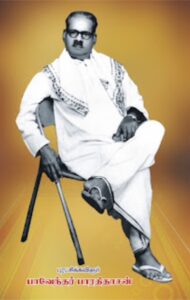ROLE OF PRANAYAMA IN ENHANCING MEMORY SKILLS OF STUDENTS LEADING TO BETTER ACADEMIC PERFORMANCE

R. MALATHI* and V.RAMADAS**
M.Phil Scholar*, Associate Professor** Department of Yoga for Human Excellence, WCSC- VISION SKY Research Centre, Aliyar, Pollachi-642101.
******
ABSTRACT
Yoga is an ancient philosophical and religious tradition thought to have originated in India in 5000 BC. It has been incorporated into modern medicine during the few decades because of the increasing incidence of diseases of modern civilization such as obesity, hypertension, coronary artery diseases, and diabetes mellitus, which are rooted in faulty lifestyle and psychological stress. Yoga is the best lifestyle modification, which aims to attain the unity of mind, body, and spirit through asanas (exercise), pranayama (breathing), and meditation. Student communities are the pillars of the future world. Clever and blooming students become responsible citizens. This article is aimed to provide insight into the part of academic stress among young adults, their emotional adjustment and coping mechanism. Various studies have stated that disturbing number of students are not able to handle their stress due to the heavy syllabus and expectations of their parents. This has resulted in having a risky outcome for the students, leading them to mental health issues like depression and fretfulness. It leads to a lack of interest, poor concentration and scoring low marks in their studies. In order to overcome such issues, most of the educational institutions follow the Yoga system and provide yoga practices like Asana, meditation and Moral values for relaxing and improving physical and mental health among students. However, Pranayama is the best method of enhancing the memory power of students and it is part of the yoga system. Pranayama is the formal practice of controlling the breath, which is the source of our prana, or vital life force. Here, read up on pranayama exercises and poses, breathing techniques and sequences. It helps one to regulate breathing, improving oxygen level in our body, especially the uniform supply of oxygen to the brain. It leads to getting better and excellent memory skills in students, leading to better academic performance especially scoring high marks.
Keywords: Yoga – Pranayama – School Students – Reduce Stress – Depression – Enhancing Memory Skills – Better academic Performance.
Introduction:
Thousands of years ago, yoga originated in India, and in present-day and age, an alarming awareness was observed in health and natural remedies among people by yoga and pranayama which has been proven an effective method for improving health in addition to prevention and management of diseases. With increasing scientific research in yoga, its therapeutic aspects are also being explored. Yoga is reported to reduce stress and anxiety, improve autonomic functions by triggering neuro-hormonal mechanisms by the suppression of sympathetic activity, and even, nowadays, several reports suggested yoga is beneficial for the physical health of cancer patients. Such global recognition of yoga also testifies to India’s growing cultural influence. Student communities are the pillars of the future world. Clever and blooming students become responsible citizens. This article is aimed to provide insight into the role of academic stress among young adults, their emotional adjustment and coping mechanism. Various studies have stated that, due to anxiety, due to the heavy syllabus and expectations of their parents’ many students are not able to handle their studies properly. This has resulted in having a risky outcome for the students, leading them to mental health issues like depression and fretfulness. It leads to a lack of interest, poor concentration and scoring low marks in their studies. In order to overcome such issues, most of the educational institutions follow the Yoga system and provide yoga practices like Asana, Meditation, and Moral values for relaxing and improving the physical and mental health of students. However, Pranayama is the best method of enhancing the memory power of students. Pranayama is a Sanskrit word alternatively translated as “extension of the praṇa (breath or life force)” or “breath control.” The word is composed from two Sanskrit words: Prana meaning life force (noted particularly as the breath), and either Ayama (to restrain or control the prana, implying a set of breathing techniques where the breath is intentionally altered in order to produce specific results) or the negative form ayāma, meaning to extend or draw out (as in extension of the life force).
It is a yogic discipline that originated from ancient India. Pranayama is a well-planned yoga system. It helps in regulating our breathing, improving oxygen levels in our body, especially the brain. Pranayama is an essential limb of the Yoga system. Pranayama is the regulation of inhalation and exhalation. It is an art and has techniques to make the respiratory organ move and expand internally, rhythmically and intensively (Srinivasan, 1991). The practice of Pranayama is necessary for removing all impurities in the nadis or the subtle channels through which the pranic energy flows in the body. The tranquility of mind, overcoming disease and the fear of death are the outcomes of proper practice of Pranayama (Digambariji, 1970).
Literature Review:
Many people in the USA today claim to practice yoga for its health benefits, without consciously adopting Hindu religious perspectives which underlies the practice and usually become apparent in more advanced stages of instruction. Elementary courses of hatha yoga focus on physical exercises consisting of various postures and breathing techniques. A growing body of research evidence supports the belief that certain yoga techniques may improve physical and mental health through the regulation of the Hypothalamic Pituitary Adrenal (HPA) axis and the sympathetic nervous system. Stress and stress-induced disorders like Hypertension and Angina are fast-growing epidemics. They are the bane of “modern” society. The holistic science of yoga is the best method for prevention as well as management of stress and stress-induced disorders. Numerous studies have shown yoga to have an immediate curing effect on both the HPA axis responses to stress. The effectiveness of yoga against stress management is well established (Michalsen et al., 2005). It is also identified that brief yoga-based relaxation training normalizes the function of the autonomic nervous system by deviating both sympathetic and parasympathetic indices toward a more “normal” middle region of the reference values. Studies show that yoga decreases levels of salivary cortisol, blood glucose, as well as plasma renin levels, and 24-h urine nor-epinephrine and epinephrine levels. Yoga significantly decreases heart rate and systolic and diastolic blood pressures. These studies suggest that yoga has an immediate quietening effect on the HPA axis response to stress. While the precise mechanism of action has not been determined, it will be hypothesized that some yoga exercises cause a shift toward parasympathetic nervous system dominance, possibly via direct vagal stimulation noted significant reductions in low-frequency heart rate variability – a sign of sympathetic nervous system activation – in depressed patients following an 8-week yoga intervention. Regardless of the pathophysiologic pathway, yoga has been shown to have immediate psychological effects: decreasing anxiety and increasing feelings of emotional, social, and spiritual well-being (Kirkwood et al., 2005).
Present-day students and their problems:
Academic performance is concerned with the quantity and quality of learning attained in a subject or group of subjects after a long period of instruction. Today students have excessive stress hampers on performance. This study shows how Yoga and Pranayama help to improve academic performance and alertness among college students. Improvement in academic performance and alertness has been reported in several yogic studies. The population of the study consisted of students from the College of Agriculture, Waghai sample study. Questionnaires are used to collect information regarding their views. The data collected are analyzed using statistical tools. The outcome of the study indicated, how student performance is effectively improved by Yoga and Pranayama. Many psychiatrists have articulated their apprehension at the emergence of educational strain faced by students leading to the high occurrence of deaths by committing suicide. The research has postulated that many youths in India are asked to visit a psychiatrist for school-related distress, exhibiting higher levels of anxiety, refusal from going to school, phobia, physical complaints, prone to depression, weeping spells, irritability and decreased interest in performing school tasks. The education institutions organize quite a few activities that can build up their knowledge of interface among the existence. Meanwhile, it can create more stress for students. Furthermore, the above problems affect the productivity or the outcome students perform. When students are stressed they do not give their level best results, it manifests in the outputs they bring to get in the grades, lack of ability to bring up new ideas to solve problems and force issues. (George, 2017) When the students have to practice pranayama, they become more tolerable and value education and co-curricular activities too. The rhythm of breath to eliminate anxiety and support the various organs and systems within the body, transform overpowering emotion, it supports to restore the action of mental peace, thus supporting the whole mind-body system.
Definition of Pranayama:
Prana is the infinite, raw energy of the Universe. One who has learned how to control prana controls all the energies of the Universe, thus controlling his or her body and mind. In Sanskrit, Pran means Breath and Ayama means control so it is called Pranayama. Pranayama is the complete breathing exercise; it cures our body internally if we practice regularly. Pranayama is an excellent breathing exercise for our healthy life and releasing stress and depression (Vedraj, 2013). It consists of a long, sustained flow of inhalation (puraka), exhalation (rechaka), and retention of breath (kumbhaka). Puraka stimulates the system; rechaka throws out vitiated air and toxins; kumbhaka distributes the energy throughout the body. This disciplined breathing helps the mind to concentrate and enables the sadhaka to attain robust health and longevity.
The excellence of Pranayama:
Our breathing is a perfectly accurate and honest barometer for our emotions. We can feel ourselves how stress affects the ease and pace of our breathing, especially the way we inhale. If you become aware of this strained condition, you can “heal” yourself simply by taking a few conscious breaths – soft, deep and slow. Instantly, you will discover that a deep peace settles in your mind. Conscious breathing is quite elementary and extremely efficient. Taking soft deep breaths should provide you with an immediate sense of how to manage the restlessness in your body and your galloping thoughts by simply controlling your breath (Stig,2010). During Pranayama, the diaphragm is raised naturally to the thoracic cavity and we can manipulate the abdominal muscles. Again, as long as our diaphragm is in the raised position, air pumps the abdominal muscles inward and outward in quick succession. (Vishnudevanand, 1960). Pranayama produces improvement in neural function at both central and peripheral levels of the nervous system and also balances sympathetic and parasympathetic limbs of the autonomic nervous system. This homeostatic “Samatvam” is a potent vaccine and antidote to the pandemic of stress disorders (Ananda, 2016). Pranayama is a powerful tool that stimulates the brain and improves the power of memory. During pranayama the mind is focused on breath, the level of the oxygen also increases in the body and brain by the regulation of breath; it helps in improving concentration and memory.
Enhancing concentration and memory skills through Pranayama:
Concentration means wholeness, unity, equilibrium. It is focusing of attention upon a particular object. Memory is an ability to recall or remember past events or previously learned information or skills. The process of concentration of attention and power of recalling are the major factors in learning. Improvement in concentration and memory has been reported in yogic studies, while many studies report brain electrical activity or EEG changes during Pranayama, increases blood circulation to head region and improve the amount of oxygenation to head. This will help us to keep calm, focused and sharp concentration and memory skills. The students who are exposed to pranayama are sure to enhance memory and improved concentration (Ram, 2015). The regular practice of pranayama makes the body attractive, strong and healthy. Too much fat is reduced. There is luster in the face. Eyes sparkle like a diamond. The voice becomes sweet and melodious. The student is free from all sorts of disease and becomes so perfect and smart; his mind will not be shaken. When the mind is raised into the superconscious state of perfection, it begins to act from there and experience higher facts and greater knowledge. Such is the ultimate object of yoga, which is achieved by the practice of Pranayama. Another yoga researcher, Boston University’s Chris Streeter, found evidence of yoga’s potential to help treat anxiety and depression. In her studies, Dr. Streeter scanned the brains of yoga practitioners and found that, compared with walking, yoga produces a decrease in anxiety and boosts brain chemical that enhances our mood.
Conclusion:
Pranayama is frequently called Breath control. The students, who practice pranayama achieve higher concentration and memory skills. It is a useful tool to keep a person healthy throughout life, by regular practice. Reports of various authors indicate that Pranayama improves the way our brain functions, including our ability to concentrate and perform well on academic performances.
References:
- Ananda Balayogi Bhavanani, 2016. Power of Pranayama; Yogachara.
- Fazilah Idrisa and Zaharah Hassana, 2001. The role of education in shaping youth’s national identity.
- George Essel and Patrick Owusu; 2017; Causes of students’ stress, its effects on their academic success, and stress management by students, pp.29.
- Iyengar B.K.S 1989. Light on Pranayama Cross road, N. Y., p. 14.
- Kirkwood G, Rampes H, Tuffrey V, Richardson J, Pilkington K, Ramaratnam S. Yoga for anxiety: A systematic review of the research evidence. Br J Sports Med.39:884–91.
- Michalsen A, Grossman P, Acil A, Langhorst J, Ludtke R, Esch T, 2005, Rapid stress reduction and anxiolysis among distressed women as a consequence of a three-month intensive yoga program. Med Sci Monit. 11:555–61.
- Ram Kalap Tiwari, 2015. Benefits of Yoga Practices on High school student’s memory and concentration in relation to Examination stress, Volume: 4, Issue: 2, pp.27-29.
- Srinivasan, T.M.; July & October 1991; Pranayama and Brain Correlates, pp. 1–6 Vol., No. XI No.1 & 2.
- Stig Avall Severinsen, 2010. Breatheology – the art of conscious breathing; pp. 25.
- Swami Digambarji and Pundit Kopkaje (Ed); Hatapradipika of Svatmarama Kaivalyadhama SMYM, Lonavala, p. 52 – 59 (1970).
- Swami Vishnudevan, 1960. The Complete Illustrated Book of Yoga. The Julian Press, N. Y., p. 24.
- Vedraj Menon, 2013 Seven Pranayama, Breathing Exercises, and Benefits.
- yogabasics.com/learn/improving-memory-and-concentration.








